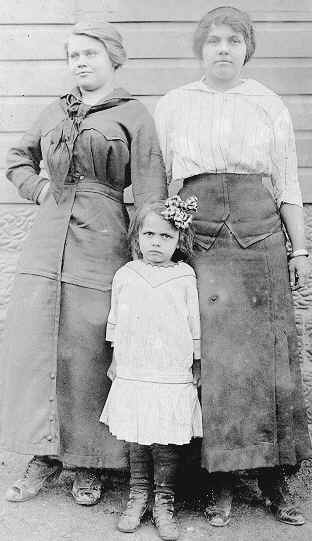 Dressed in outfits typical of the day, this photo of town
residents is from about 1918. Note the button-up boots on all three. Although
men's clothing has not changed significantly, women's fashions changed
considerably over the decades.
Dressed in outfits typical of the day, this photo of town
residents is from about 1918. Note the button-up boots on all three. Although
men's clothing has not changed significantly, women's fashions changed
considerably over the decades.
Two Young Women and Girl
 Dressed in outfits typical of the day, this photo of town
residents is from about 1918. Note the button-up boots on all three. Although
men's clothing has not changed significantly, women's fashions changed
considerably over the decades.
Dressed in outfits typical of the day, this photo of town
residents is from about 1918. Note the button-up boots on all three. Although
men's clothing has not changed significantly, women's fashions changed
considerably over the decades.
Several studies in professional journals on life in coal mining towns were done in the early part of the 20th century. In 1909, the American Journal of Sociology published an article, "Life in the Pennsylvania Coal Fields with Particular Reference to Women." This was the first study which investigated the lives of women in coal towns. Among the needs of the coal town immigrants, the author cites better housing, public baths, and amusements to offset the influence of bars. The author also indicates that the learning of English was the most important need of all. Another conclusion reached by the author in this 1909 study was the necessity for female immigrants to fraternize with Americans. Doing so would enable them to learn and better perform domestic duties such as cooking, cleaning, sewing, and caring for their children and the sick.
Another study, in a 1920 issue of the Monthly Labor Review
entitled "Housing: Company Housing in the Bituminous Coal Fields,"
discussed the layout of towns, type, construction and size of houses, sanitary
conditions, maintenance, and rents. According to this report, the typical
coal town had few amenities, and homes, in general, were poorly constructed.
In 1922, the United States Coal Commission was appointed by President Harding
to study various aspects of the coal industry. The development of a national
coal policy guided by the commission's recommendations was the goal of the
study. A wide
range of subjects were covered and resulted in the publication of 5 volumes of texts and tables.
One of the topics covered was
how the miners lived. Statistics and information on ethnic origins, literacy, community
health and sanitation, cost-of-living, and accidents and health were gathered
and interpreted. In the area of literacy, of the total number of foreign born
bituminous workers, about 77 per cent could read and write [in their own
language]. About 13 per cent could not speak English.
Annie Marion MacLean,
"Life in the Pennsylvania Coal Fields with Particular Reference to
Women,"
American Journal of Sociology 14 (l909): 331.
Leifur Magnusson, "Housing: Company Housing
in the Bituminous Coal Fields,"
Monthly Labor Review 10 (1920): 215.
Edward Eyre Hunt, ed., What the Coal Commission Found (Baltimore: Williams and Wilkins, 1925), 17-19, 137, 403-408.
Photo: courtesy Ed Setlock family collection.